Taste the Opulence: The Top 10 Most Expensive Fruits in the World
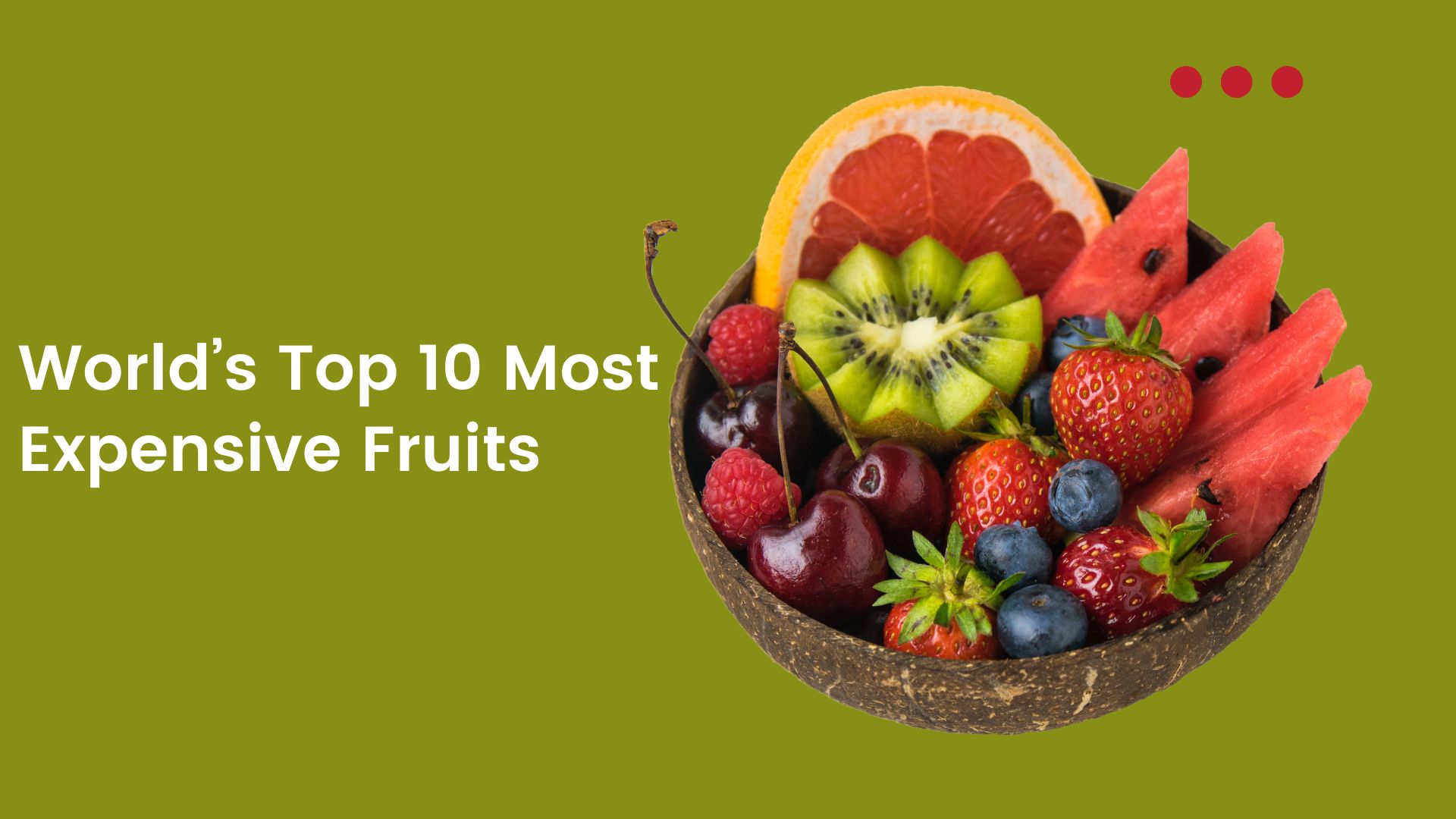
Page Contents
Fruits are a crucial component of a robust diet because they include active nutrients including vitamins, minerals, and fiber. They produce pods that both humans and other creatures consume, providing them with the breeding pathway of expanding stores. Fruits bloom in a wide range of forms, dimensions, and aromas, ranging from pleasant to sour and sometimes caustic. Apples, bananas, oranges, grapes, and strawberries are a few prominent fruits. Furthermore, fruits have applications in milkshakes, cookery, and gourmet. It is encouraged for good eating to comprise a wide range of fruit, that can be enjoyed as a snack or included in confectionery. This article will focus on the world’s top 10 most expensive fruits.
History of Fruits:
Fruit intake has been documented in prehistoric societies like Egypt and Greece. Fruits have been an essential component of mortal diets. In contrast, these communities cultivated an abundance of often-consumed momentary fruits, including apples, grapes, and figs.
Fruits were highly respected in previous eras for their natural sweetness and nutritional benefits. They were also utilized for therapeutic purposes; comparable fruits like cranberries and figs were considered to have therapeutic virtues. Fruits were widely seen as emblems of profusion and vitality in sacred practices.
Fruit horticulture has become more prevalent amongst monastic as well as other devotional communities in their large halls as fruit civilizations expanded across Europe throughout the Eighteenth Century. Fruits were regarded as extravagant that was only attainable to the privileged and prosperous.
European explorers emerged with different varieties of fruits throughout their voyages in the sixteenth and seventeenth centuries, including citrus fruits related to grapefruit and lemons from Asia. These berries were renowned for their significant levels of vitamin C, which prevented seamen on long journeys from disease.
The invention of novel transportation methods in the late nineteenth century, such as sailing ships and railroads, simplified the process to export fruits over distant locations. This caused a rise in the vapidity of fruits, and thus emerged more approachable and acceptable to the generic public. Currently, fruits are a crucial part of an adequate diet and are ingested in a variety of manners. Its use ranges from salad dressings to pies and preserved galettes, and they're regular items in total, dried, or roasted. Fruits are a major revenue generator for so many nations, with substantial fruit manufacturing and importing activity in nations like the United States, China, and Brazil.
Classification of Fruits:
- Fruits can be categorized botanically according to the traits of the crop they originate from. Fruits are broken down into two main groups in this categorization: simple fruits (such as apples, oranges, and grapes), which originate from a lone ovulation of a flower petal, and collective fruits (such as pears and figs), which originate from several ovarian of a flower bud (e.g. blackberries and raspberries).
- Fruits can indeed be categorized nutritionally as per their nutritive benefits. Citrus fruits, which seem to be packed with vitamin C (such as oranges and lemons), while dried fruits, which seem to be abundant in both A and C, belong to the divisions towards which fruits lie (e.g. peaches and plums).
- Fruits can indeed be divided based on their culinary purposes. Fruits are separated by categories in this taxonomy such as cookery fruits, which are incorporated into spicy recipes, and pleasure fruits, which have been typically used in pastries (such as strawberries and blueberries) (e.g. tomatoes and avocados).
- Fruits can indeed be defined as tropical or subtropical depending on their provenance. Fruits are separated as tropical fruits (e.g., bananas, mangoes, and papayas), which seem to be native to tropical climes, and transitional fruits (e.g., apples and pears), which seem to be native to colder places.
- Fruits can be distinguished by the sort of seed they carry. Fruits are divided into pome fruits, which already have seeds encased in a solid nucleus (e.g., apples and pears), and parthenocarpic fruits, which consist of a large seed covered in a protective covering (e.g. peaches and cherries).
Benefits of Fruits:
- All fruits are high sources of vitamins and Minerals
- Most of the fruits are highly rich in fiber
- They help in improving skin health, reducing wrinkles
- Bananas and oranges have high potassium which helps in maintaining great bone health
- Fruits are low in calories they contain natural sugar which is a good source of snacks and for the fitness freak people to consume anytime.
- Fruits are a high source of antioxidants that helps in boosting the immunity
- Fruits like kiwis and oranges are high in vitamin C which is good to consume as they are good for the eyes.
Interesting Statistics:
- As recommended by the World Health Organization, adults must intake 400 grams or more of veggies and fruits each day to ensure optimal nutrition.
- Bananas, apples, and berries are the three top fruits that people in the US eat.
- As per individual chronological age and gender, adults should consume between 1.5 and 2 cups of fruit daily, per the United States Department of Agriculture (USDA).
- Based on a Grand View Research analysis, the requirement for manufacturing products and fruits internationally is expected to total USD 346.05 billion by 2025.
- There about 770 million metric tons of fruit will be generated worldwide in 2020, with China becoming the world's biggest user.
- Tomatoes are the fruit that has been most abundantly found by living beings, preceded by bananas and watermelons.
- Just one in ten adults in the U.S., based on the Department of Health and Management, ingest adequate veggies and fruit.
- Based on a survey by Grand View Research, consumer demand for organic fruit will probably exceed USD 62.97 billion by 2025.
Mentioned Below are the World’s Most Expensive Fruits:
- Yubari King Melon- worth $30,000
- Ruby Roman Grapes- worth $8,400
- Densuke Watermelon- worth $6,100
- Taiyo No Tamago Mangoes- worth $3,000
- Heligan Pineapples- worth $1,500
- Cubical Watermelon- worth $800
- Strawberry “Sembikiya Queen Strawberries”- worth $85
- Orange Dekopan- worth $80
- Sekai Ichi Apples- worth $12
- Buddha-Shaped Pears- worth $9
#1. Yubari King Melon – Worth $30,000
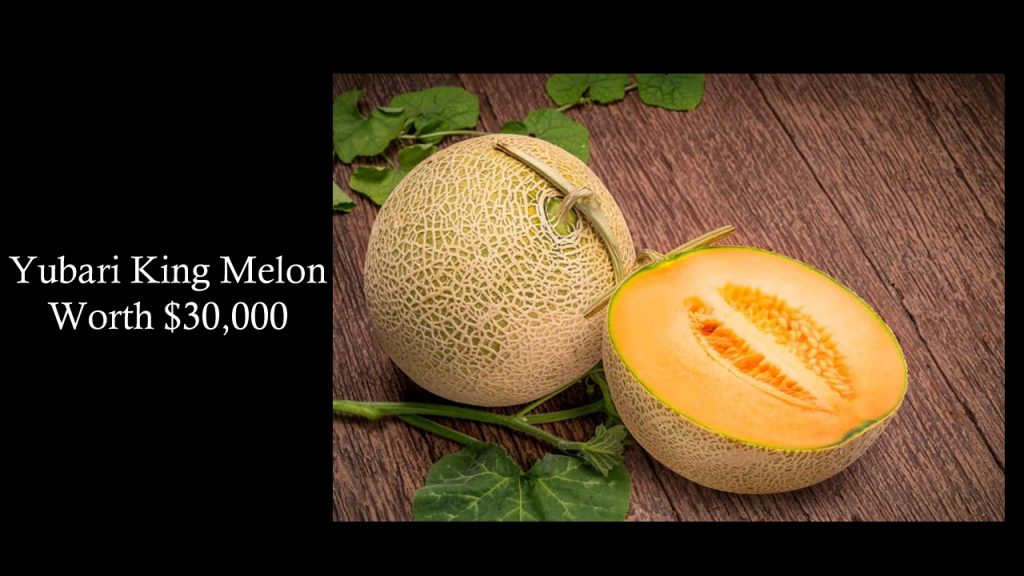
Premium melon designated as Yubari King Melon is harvested in Yubari, Japan's hills. Yubari King Melon is indeed a fruit that is secured by territorial indicators; as a response, it carries a foremost advantage of around $200 and therefore is allocated for wealthy and nobility visitors.
Rockmelon (or cantaloupe) of a Yubari King Melon variety is a combination of Earl's Favorite and Burpee's Spicy. Yubari is a thought-provoking environment to develop melons because of its commanding rocky topography, rich storming topsoil, and considerable rainfall. Melons are created by certain standards because of their great pleasantness, really rounder form, perfect skin, and impressive physique adornment. That would be another justification for why the expense of Yubari King Melon is exorbitant compared to other notable crops.
#2. Ruby Roman Grapes – Worth $8,400
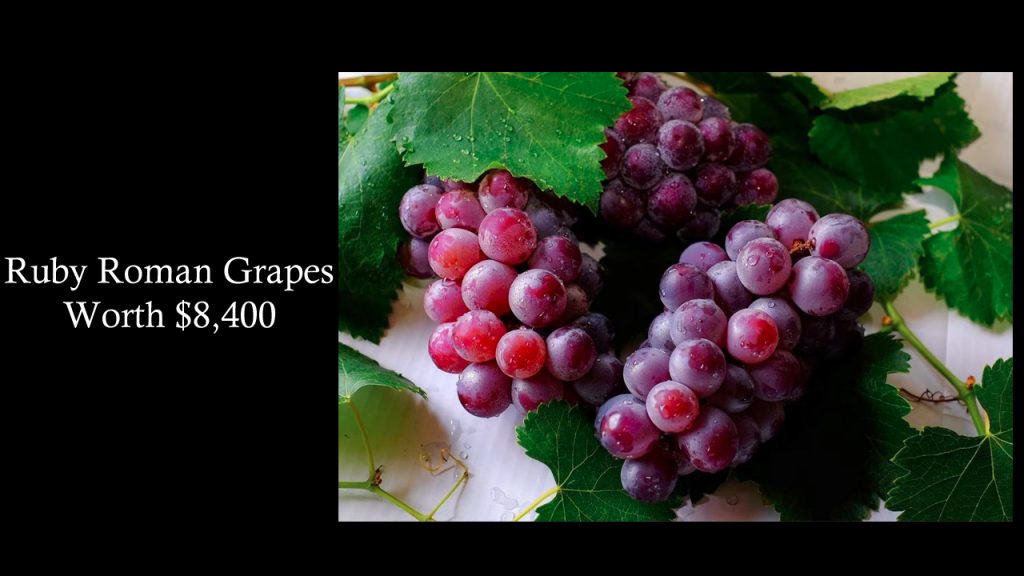
Ruby Roman Grape, another one of Japan's most valued fruits, belonged to civilization. This originated from Ishikawa Province in Japan, where it can be bought, harvested, and transported. Ruby Roman grapes were traded in their maiden exchange in 2008 for more than 20,000 Japanese yen.
Roman Ruby grapes have only had one fruit blooming color that had been deliberately manufactured in 1995 by the founding farmers and Ishikawa's Agricultural Research Center. Roman Ruby grapes are constantly at the highest position on the list of the most magnificent fruits in recorded existence because of an evolving technique that adheres to rigorous standards of quality throughout a special period.
#3. Densuke Watermelon – Worth $6,100 each
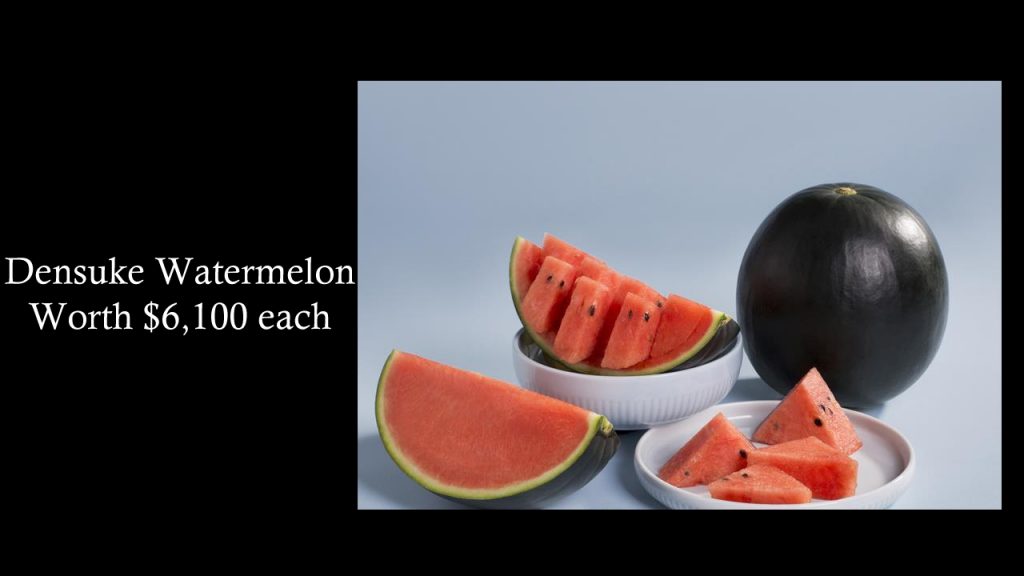
The Japanese island of Hokkaido is really where Densuke watermelon, also characterized as an ebony watermelon, is most often harvested. This melon currently ranks as among the most valuable both in Japan and indeed the entire globe. The most lucrative purchase had seen the so-called “king of melons,” Densuke Watermelon, traded off for above USD 100.
Each aspect of Densuke Watermelon's expansion is meticulous and standardized. So, just a hundred fruits are harvested each time, and each fruit weighs about five and ten kg. The recesses of the Densuke Watermelon are bright red, delicious, and tender, while its exterior is a thicker and more polished black than that of other melons. If one wishes to experience this beautiful fruit, one could acquire it at an additional reasonable cost of almost 45 USD per kg; it is distributed by the collective in the area of Toma.
#4. Taiyo No Tamago Mangoes – Worth $3,000
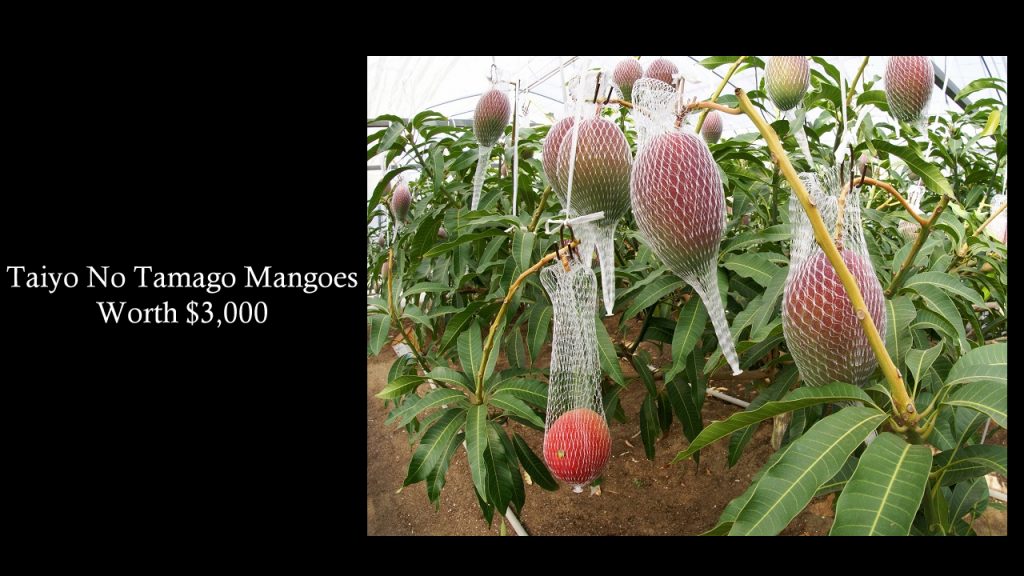
The fruit designated as Taiyo No Tamago mango, generally regarded as the sun's egg, is found abundantly in Miyazaki Prefecture as well as supplied across Japan. These 2 different mangoes have always been auctioned at a record-breaking cost of production of $3,744 in Japan in 2017. The aspect of cause of the steep market value was the farmers' employment caretaking techniques, which also supplemented conventional harvesting by letting mangoes naturally fall while trying to preserve suitable anecdotes and elevated mango food.
In Florida, the Irwin mango initially evolved in the 1940s. Presently, this fruit is commercially farmed and trades for approximately $50, which makes it less costly for beaneries to savor.
#5. Heligan Pineapples – Worth $1,500 each
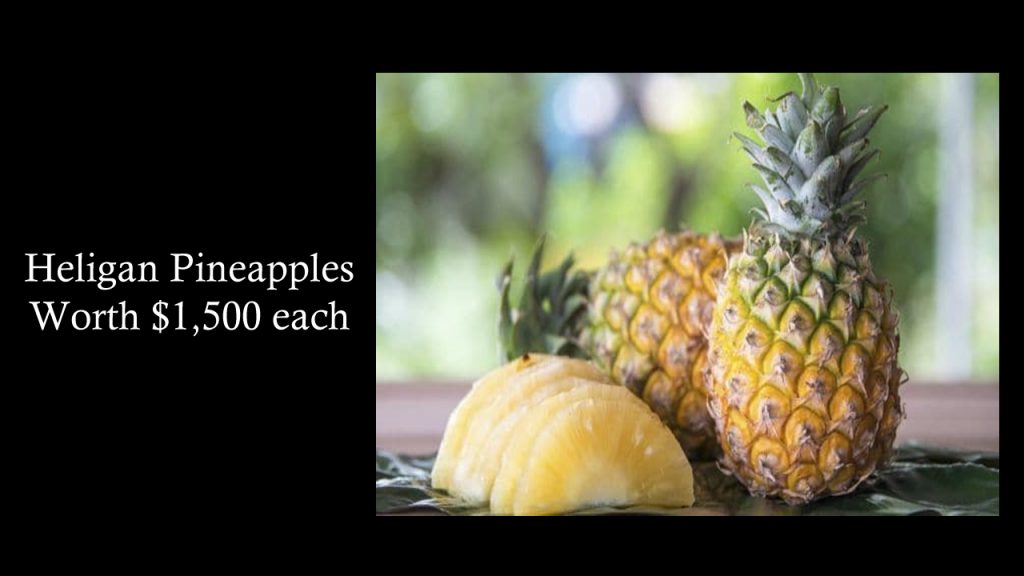
Among the most infamous arenas in the UK, the Lost arenas of Heligan are found adjacent to Mevagissey in Cornwall, England. Besides this, the variety of pineapple farmed by farmers back then is also valuable, ranging from 10,000 pounds (original) to 16,161 Dollars.
Heligan pineapples are cultivated in developed specifically recessed which are continuously warmed by a source of immaculate putrifying effluence. The magnitude of this warmth melts the soil that penetrates the depths of wall gaps. The expenditure of caring, preserving, and shipping Heligan pineapples is also substantially more than that of other types of pineapples, and they are not harvested as per seasonal periods.
#6. Cubical Watermelon – Worth $800 Each
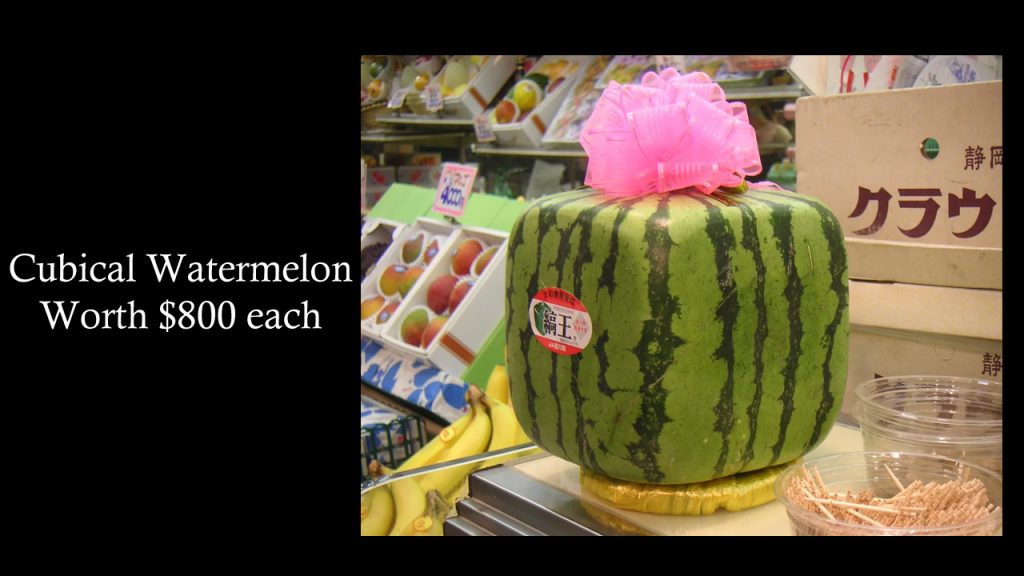
The fruit termed the “cubical watermelon” is produced in a cubicle structure to give it a lone aspect. Depending on how big it is, each melon might keep bringing up to$ 200. The innovation of generating quadrate melons first originated in Japan during the latter part of the 1970s. They were developed organically and are kept coated throughout the development procedure to make sure that the cells don't break as well as the stripes stay perfectly vertical.
This quadrate melon may be planted throughout the year, but the crystallizing phase becomes the most fragile, boosting the value of the fruit. Yet or even, cubic watermelons are now extensively propagated worldwide and are marketed at prices as low as USD 30.
#7. Sembikiya Queen Strawberries – Worth $85/pack
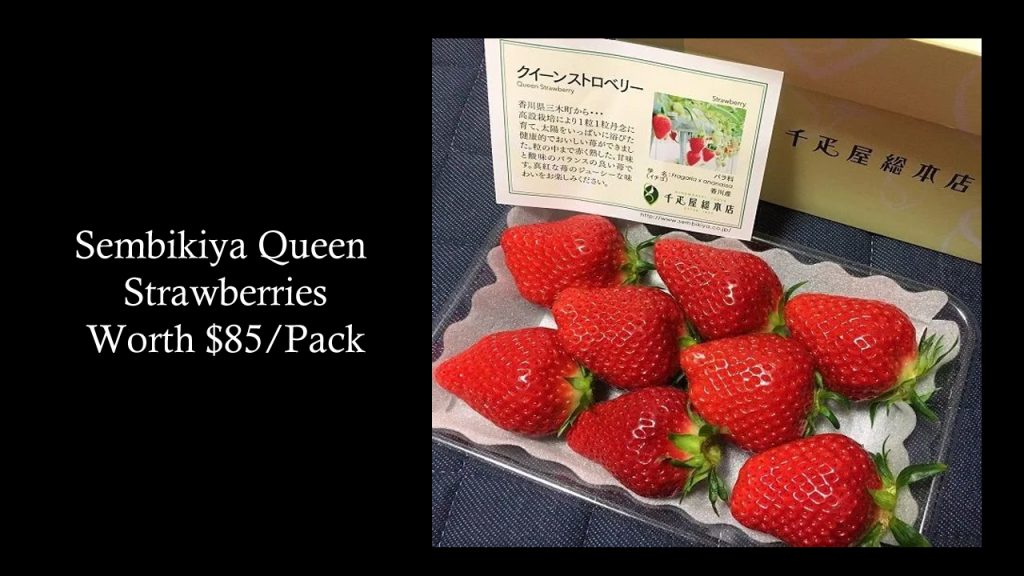
Strawberries classified as Sembikiya diva strawberries or Nyohou strawberries originated in 1834 and are titled after a prominent fruit shop in Tokyo. Each container of 12 cherries costs $85 and is accessible for purchase. The manufacturer carefully identifies each box by hand and packages it to improve consistency when necessary.
The preponderance of Sembikiya queen strawberries has a bright red hue, a sweetness, and beautiful, well-structured green verdure. Despite its expensive pricing, many people praise this berry, and many companies export it throughout several multiple nations.
#8. Orange Dekopon – Worth $80/per six pack
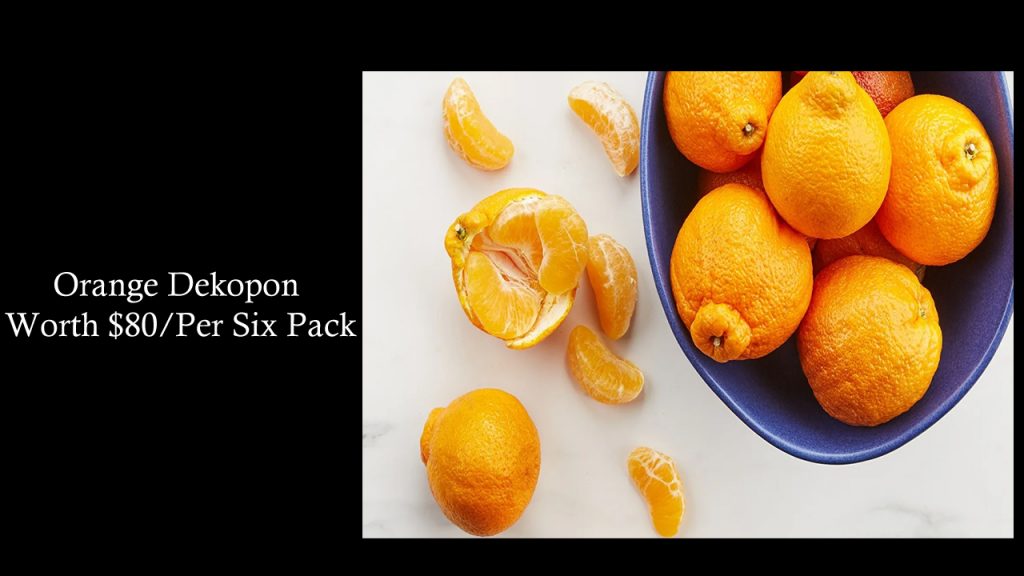
Among a kiyomi public servant as well as a ponkan public servant, Tangerine Dekopon is a hybridization that is primarily planted in Japan around leisure as well as in springtime in native California. This fruit does have a specific appellation in distinguishing locations. Dekopon is also recognized as Shiranui in Japan as well as Hallabong in Korea, whilst in the US they are more commonly known as Sumos.
With prices starting at 80 USD, Orange Dekopon is the most delicious member of the citrus family and is among the most expensive version of citrus fruits available worldwide. Despite its prohibitive price, Tangerine Dekopon consistently looks elegant on grocery shelves in America. It has a deliciousness and a gorgeous expression.
#9. Sekai Ichi Apples – Worth $12
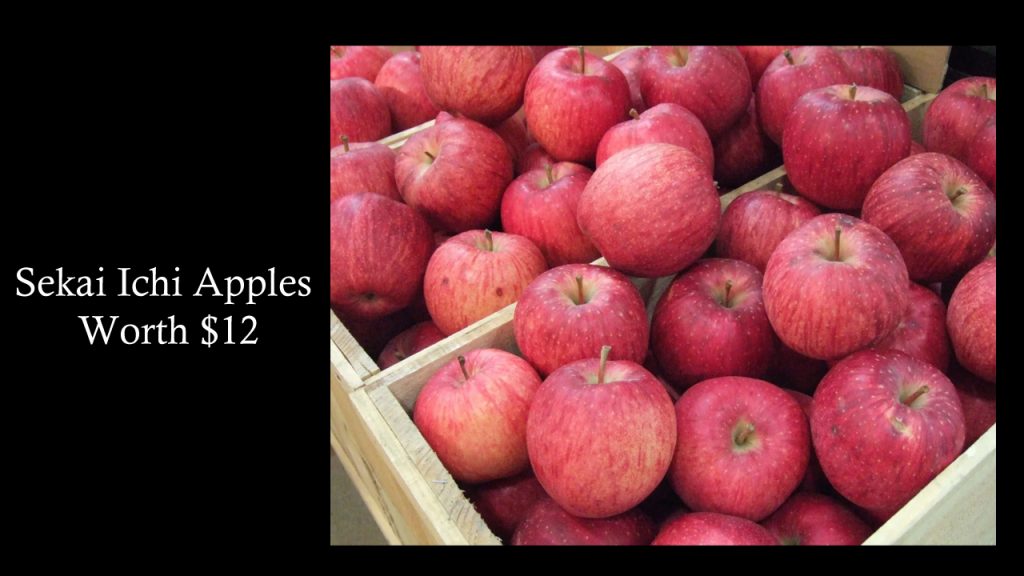
Sekai Ichi apples, recognized to have been the most valuable apples in recorded existence, are harvested in Japan and offered for some more than $20 each in retailers. Apples first were planted in Morioka, although they are now predominantly planted in Aomori, including in Japan.
Each apple is broader than its siblings and feels delicious and fluffy. Its core is brick-like, sturdy, and moist. Apples are often harvested in the drop, and also to ensure that they're stored perfectly, the gardener has soaked them in honey and personally infused them. The Sekai Ichi apple has still been considered cheap for those who might be intrigued by any of it.
#10. Buddha-Shaped Pears – Worth $9
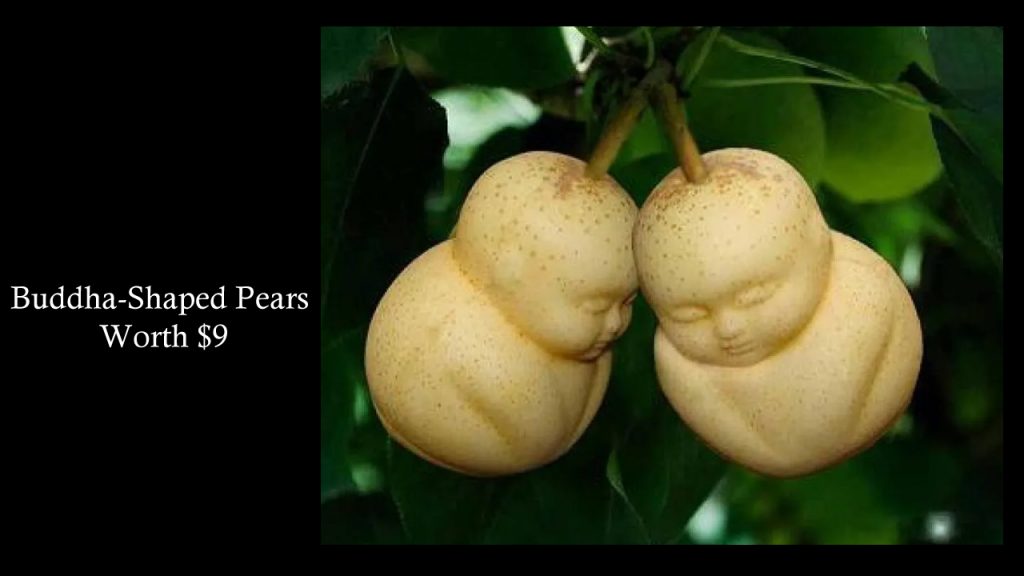
Farmers in China's Hebei province are recognized for creating the Sage pear. Melon has a solitary Buddha design, but it is trimmed perfectly normally and therefore is kept a check on, comparable to other trendy orchards in Asia. If you'd like to try this specific fruit, this only takes you approximately $9 per piece.
Pears were created in casts that have been prepared to resemble frail Buddhist monks throughout antiquity. The Buddha-shaped melon does have a flavor that isn't particularly remarkable from conventional melons during admiring, but rather, it consistently has a lofty absorption because of its peculiar appearance that piques people's curiosity and encourages Buddhists should want to worship.
Bottom line:
Superior fruits tend to have pricing that is substantially greater than the typical pricing of fruits. These berries are typically magnificent or exquisite, therefore making them difficult to get and sell and adding to their significant expense. The Japanese Yubari melon, which could sell for up to $45 per slice, as well as the Ruby Roman grapes, which could also sell for as much as $2,000 per cluster, are 2 of the most premium products.
Whereas these fruits could appear to be a luxury gift, they do not provide much more nourishment than some other, more readily available fruits. No, regardless of how costly they are, devouring an array of fruits is necessary for a sane diet. It's also worth pointing out that several readily available fruits, such as bananas and oranges, confer numerous health benefits and are readily accessible. Despite the costlier fruits that can serve as a delight among some, they might not even ineluctably provide higher nutrients contrasted to cheaper options. Maintaining strong athleticism requires a very well diet that incorporates an array of fruits, and there are a lot of economical and delightful accessories available.
FAQ.
Pineapple is the most "fortunate" fruit because it's regarded in Chinese as "ong-lai," which translates as "fate wands."
The Southeast Asian shrub Durian has indeed been labelled the "Prince of Fruits," but like Miso, it splits opinions strongly among those who enjoy the tastes of its caramel flesh as well as those repelled by its rotten odour.
The peach is connected to wellness, wealth, and happiness. This berry is also associated with marriage and romantic relationships.
Mangosteen fruit is also referred to as the Princess of Fruit. Mangosteen has been well renowned because of its taste as well as the claim that this improves a healthy lifestyle.

Aditi is an Industry Analyst at Enterprise Apps Today and specializes in statistical analysis, survey research and content writing services. She currently writes articles related to the "most expensive" category.